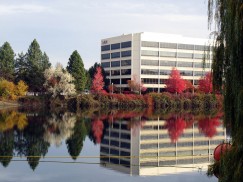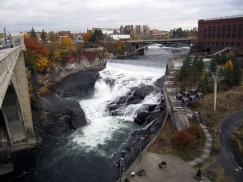- Home
- >
- Press Releases/Announcements
- >
- Report from the 2012 National Preservation Confere...
By Bill Doelle, Archaeology Southwest President & CEO

The National Trust for Historic Preservation holds an annual conference in a different U.S. city each year. Last week, from October 31 through November 2, we converged on Spokane, Washington, a city of 209,000 that has a robust historic downtown.
There was just enough time during my two and a half days at the meetings to get a taste of Spokane. Coming from the desert, it was a treat to attend a meeting located next to a river with abundant water at a time of year when the deciduous trees were changing color. The sun even shone through the thick clouds a couple of times to further enhance the scene from just outside the convention center. And before catching a plane on Friday, I was able to catch a glimpse of the falls of the Spokane River, where white water pours abundantly over dark basalt. It was a memorable final view on this quick trip to the northwest.
Now, to business…

Archaeology Southwest is a Local Partner of the National Trust. We work together to advocate for the expansion of Casa Grande Ruins National Monument, for the creation of a Great Bend of the Gila National Monument, and on numerous public lands issues, including the SunZia power line.
This year, I attended in order to participate in an education session organized by Bill Lipe, Professor Emeritus at Washington State University. With three other colleagues, I addressed “Archaeological Preservation Perspectives in the Southwest.” It is actually a bit rare for archaeology to be featured at National Trust meetings, so we were pleased with our audience of about thirty-five people. As Bill Lipe noted, “They were an engaged audience.”
The lead topic made the national news in September, when President Obama used the Antiquities Act of 1906 to designate Chimney Rock National Monument. Denise Ryan of the National Trust for Historic Preservation explained the Trust’s new focus on National Treasures®—and Chimney Rock is a National Treasure® that she advanced with high energy and ultimate success. Deborah Gangloff, President of the nonprofit Crow Canyon Archaeological Center in Dolores, Colorado, played a significant supporting role in the national monument effort. In her presentation, she made a strong case for the economic benefits of heritage tourism in rural areas such as southwestern Colorado. It’s a great Preservation Archaeology message: preserving the places of the past and sharing them with the public makes economic sense!

Andrew Duff, chair of the Department of Anthropology at Washington State University, recounted the process by which Zuni Salt Lake was listed on the National Register of Historic Places as a Traditional Cultural Property that covers 285 square miles. Andrew shared stories from the four Pueblos—Zuni, Hopi, Acoma, and Laguna—that hold this place sacred. These are powerful stories, even when conveyed by an archaeologist. Much of this story is also presented in the Archaeology Southwest Magazine issue 22(1) from 2008, which is available for free download on our website.
As the final presenter, I shared the history of Archaeology Southwest’s work in the San Pedro valley and highlighted our development of a Priority Cultural Resources Planning process. We began the Priority Sites process in the San Pedro Valley in 2008 (click highlighted phrase to dowload PDF), and we recently published our final report on the work we did with Pinal County late in 2010 (click highlighted phrase to download PDF). We continue to extend this process across the Southwest. We are finalizing our report on the Upper Gila and Mimbres areas, and we just announced our upcoming Salado Priority Sites workshops, which will take place this fall in Tucson and Phoenix.
Explore the News
-
Join Today
Keep up with the latest discoveries in southwestern archaeology. Join today, and receive Archaeology Southwest Magazine, among other member benefits.